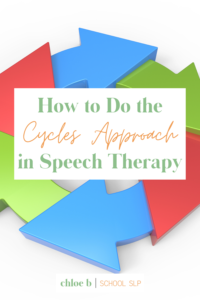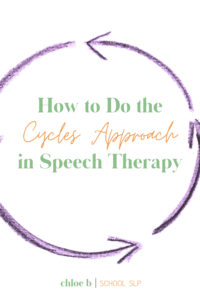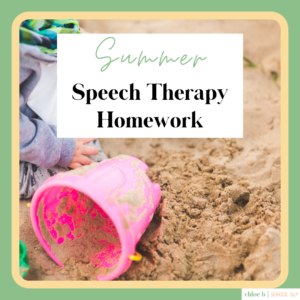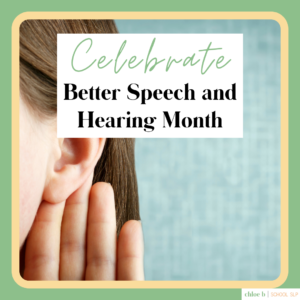Are you wondering about the cycles approach to speech therapy? It’s an approach to treat speech sound disorders that’s gaining a lot of traction recently. More and more speech therapists are learning about Barbara Hodson’s research and her creation of the Cycles Phonological Remediation Approach.
What is the Cycles Approach?
The cycles approach is a method used to treat phonological patterns (formerly known as phonological processes). Here are some examples of phonological patterns and the year in which they should be eliminated (no longer used by the child) –
By 3 Years
- Velar Assimilation (tap –> cap)
- Pre-Vocalic Voicing (pig –> big)
- Final consonant Devoicing (big –> bick)
- Final Consonant Deletion (hat –> ha)
By 3.5 Years
- Stopping of Fricatives (sun –> tun)
- Weak Syllable Deletion (elephant –> efant)
- Velar and Palatal Fronting (can –> tan)
By 4 Years
- Cluster Reduction (space –> sace)
By 4.5 Years
- Deaffrication (chip –> ship)
- Stopping of affricates (jump –> dump)
By 5 Years
- Gliding (lake –> wake)
By 6 Years
- Fricative Simplification (thmb –> fum)
Sometimes a child will struggle with a lot of these patterns. A child may also struggle with childhood apraxia of speech. The cycles approach is when you target specific error patterns by ‘cycling’ through them for a set amount of time. Each sound within an error pattern is targeted and then it switches (even before your child masters it) to the next sound in that pattern. Then once the child has worked on all of their error patterns the cycles begin again.
Ideally, you target primary patterns first (these are: syllable reduction, syllable structure, cluster reduction, final consonant deletion, fronting, stopping, backing, and gliding) and see if the secondary patterns will resolve themselves while you work on the primary patterns. Most students tend to fix their voicing errors and vowel errors without directly working on it!

How Do You Implement the Cycles Approach to Speech Therapy?
First, you should assess your student to see what patterns/processes you need to target. Many therapists opt for a 40-70% accuracy on stimulability. Others choose to combine the complexity approach. It is important to note that you are aiming for correct productions when you dive into the practice portion of a session.
Different therapists prefer different orders of target selection. The key is to make sure you are focusing on primary patterns (see above for list). Speechy Musings has a phonological cycles toolbox that I love, and this is the order in which she does her intervention:
- Syllable Reduction
- Syllable Structure
- Cluster Reduction
- Final Consonant Deletion
- Stopping
- Fronting
- Backing
- Gliding
She picks 5 words per session, but Amy Graham and Rebecca from Adventures in Speech Pathology (they are speech sound disorder QUEENS) both recommend 3-4 sounds. I generally use 3 words per session with my students!
Once you have your targets figured out, you are ready to go! Here is what a therapy session should look like using the cycles approach –
Session Schedule
- Review sounds from previous session / Review homework and progress
2. Auditory Bombardment (student listens to 1-2 minutes of the targeted pattern)
- Note: student can be mindlessly listening! Mine usually color, play with play dough, build with brain flakes, or help set up the game during this time
3. Practice the target words – the goal is to get 100 trials of all correct productions!
4. Auditory Bombardment (again)
5. Check for stimulability of other sounds (I like to also check for the words in sentence form to see how it’s generalizing)

How do you get 100 trials each time? On my Instagram I share lots of my favorite tips and tricks such as using an abacus or a quick turn taking game like Pop the Pig. I also sell these Boom card decks to work on minimal pairs for voicing/devoicing errors.
Do you use the cycles approach? What are some of your tips to getting 100 trials each session? Share in the comments below! And if you need tips for data collection, check out this blog post!
-Chloe B | School SLP






2 Responses